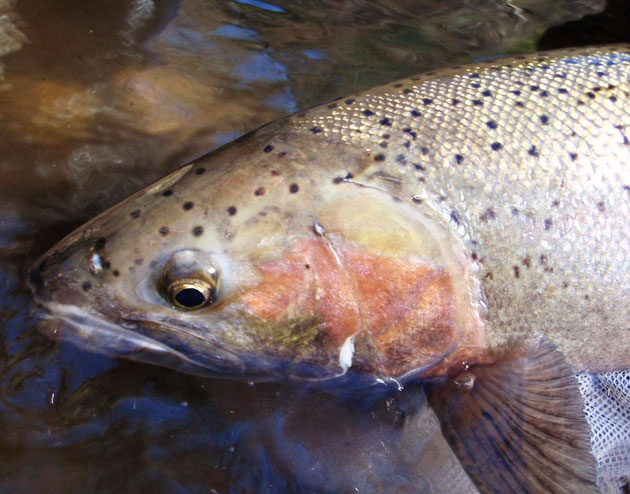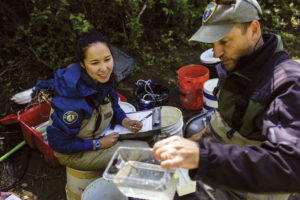hen the San Clemente Dam in Carmel Valley gets demolished next year, steelhead trout will get 25 miles of an open-water, upriver swim to find their spawning sites – something the seafaring fish haven’t had since the 106-foot-high dam was built in 1921. For scientists, the dam removal project presented the chance to study the threatened Central Coast trout before, and after, the river restoration. The setup seemed ideal: scientists could take advantage of the meticulously planned project to design simple studies that would yield high-quality research data.
But, to borrow a line from Steinbeck, the best laid plans of mice and men often go awry. Especially in scientific studies that need nature to cooperate. This year’s drought turned simple research projects into long lessons about the ways scientists have to adapt to save their studies when real life intervenes.
“It’s typical of field projects to start with one design and then have nature throws curveballs at it,” said David Boughton, a research ecologist at NOAA’s Southwest Fisheries Science Center in Santa Cruz. “But this took it to a whole new level.”
In the elegant original design, Boughton’s research group planned to put tiny tracking devices, called PIT tags, in 1,000 young trout. When the fish migrated out to sea, antenna strung across the lower river would catch and record the unique electronic IDs implanted in the fish. If those trout came back next year, the antennae would pick up that data, too. The scientists also intended to trace the fish that stayed behind in the upstream pools and tributaries. (A still-mysterious fact of trout life is that some smolt develop saltwater adaptions to swim in the sea as steeelhead while others remain riverbound and lead the freshwater life of a rainbow trout. So studying the fish that stay behind could give scientists clues about why trout “choose” the river or the ocean.)
agging those fish should have been the easy part of the study. The Sleepy Hollow steelhead rearing facility (SHSRF) crouches alongside the Carmel River, not far below the San Clemente Dam. The facility is a long, concrete channel built with riffles, pools, and overhanging branches, to mimic a natural creek. And every year, an average of 16,000 young fish are rescued from isolated pools in the river, relocated here to eat krill and grow until they’re ready to smolt.
The fish are generally released when seasonal rains raise water levels enough for the river to flow all the way to the ocean again. In drawing up the plans, you could look at the facility’s history and think of those trout as a study group just waiting to be tagged. But if you looked at last year’s weather, you’ll see where things started to go wrong.
“PIT-tagging was a first step to answer the question: Is the rearing facility producing viable smolt that migrate to the ocean, survive, and return?” Boughton said. “Then it got complicated.”
The fish rearing facility depends on water diverted from the river, and the river needs to flow at least five cubic feet per second for the facility to operate. Unfortunately, 2013 was a very dry year. Almost double the average amount of fish were rescued and taken to Sleep Hollow. Then, when the winter rains never came, the Carmel River dribbled downstream at three cubic feet per second, a flow rate that wouldn’t sustain the fish in the facility. The 10,000 young trout that survived had to be turned out in September to make do with whatever deep pools of water could be found.
“If there’s a way that nature can get in the middle of a good field study, it will,” Boughton said.
The researchers scrambled to find a place to tag, feed, and grow 1,000 of those turned-out fish until the river levels rose. Fortunately, there were big tanks available at the Southwest Fisheries Science Center in Santa Cruz. The situation wasn’t ideal because now the tagged and untagged fish wouldn’t be reared under the same conditions, and that could affect the study results. But at least the fish had a place to stay until smolting, which typically occurs during April and May. The Sleepy Hollow-reared fish were usually released earlier than that. So things should have gone, well, swimmingly. But they didn’t.
Boughton and his collaborators soon found out their fish had to leave the Santa Cruz tanks in February. Other researchers had booked those tanks for their studies and they expected them to be empty when they arrived. Once again, the trout were out. With hardly any rain all winter, the Carmel River was still at abysmally low levels. Still, there was no other option. The tagged trout went back to the river, too.
Finally, almost four inches of rain fell in February, and another three inches poured down in March. Not much, but that was a deluge compared to the previous dry months. At the Sleepy Hollow weir, water district gauges showed the river was flowing at more than 200 cubic feet per second at the beginning of February. The steelhead rode the rising river all the way to the lower valley — where they abruptly ran aground.
“The water just disappeared into the ground,” said Brian LeNeve, president of the Carmel Valley Steelhead Association. Despite the big surge, when the river ran to the lower valley, the aquifers were so depleted that the water was promptly sucked into the ground. The river never made it to the ocean. Neither did the fish.
Once again, the fish rescuers rallied, schlepping the steelhead upstream to deeper water. The fish with tags were measured, sampled, and counted.
“We have now a record of all the PIT-tagged fish rescued in lower district,” Boughton said. “We also know that some trout moved at least 5 miles downstream, a definite ‘decision‘ to head to the ocean. The interesting part will come next year, to see who makes it downstream or not.”
The researchers still had to go looking for the tagged trout that didn’t head for the ocean, the ones that stayed behind in the deep, bedrock pools. That presented a problem. Normally, the fish are rescued in shallow water using a mild electrical current that stuns them enough to be easily caught in nets. Once the fish have been moved or sampled, they can quickly be recovered and released. But that technique doesn’t work well in deep pools. So the scientists spent many frustrating hours trying to corral those fish with seine nets, 50-by-4-foot nets that catch easily on anything in stream –that is anything except fish at the bottom, which frequently escaped.
espite all the curveballs, Boughton says, they did eventually collect good data. The results haven’t been completely analyzed yet, but Boughton said he’s more pleased with the study than he expected to be.
“You try to design a study so that, whatever happens, you’ll get some answers,” Boughton said. “The corollary to that is: when nature does surprise you, it’s trying to tell you something. After all that, I’m just not sure what’s trying to tell us here.”





